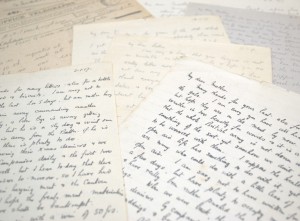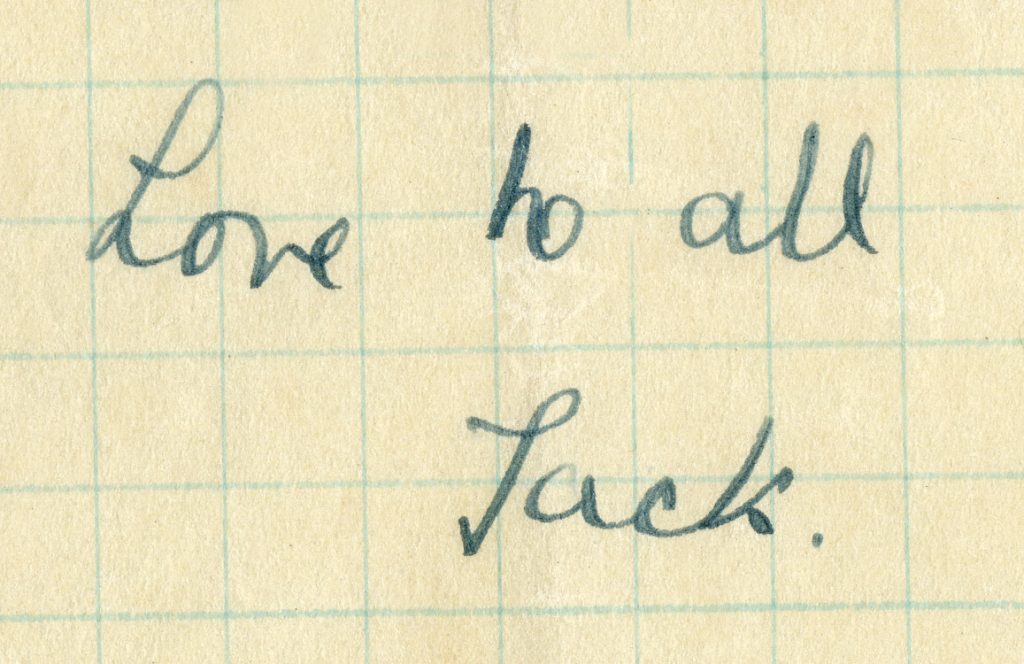As a team we have been talking more lately about the artifacts included in the Peirs collection,  as well as the considerable lack thereof. As Amy explored in her post on material culture, Jack retained few objects we might expect to see in a military memorabilia collection. Perhaps for this reason, or because of my own background as an archivist and historian, to some degree I have always considered Jack’s letters as artifacts in and of themselves.
as well as the considerable lack thereof. As Amy explored in her post on material culture, Jack retained few objects we might expect to see in a military memorabilia collection. Perhaps for this reason, or because of my own background as an archivist and historian, to some degree I have always considered Jack’s letters as artifacts in and of themselves.
Overall the appearance of the letters is remarkably consistent, with a few, regular variables. Jack’s penmanship, though distinct, is generally legible in pencil or in black ink. The stationary falls into one of three categories: first a heavy, sturdy, cream-colored paper with visible small blue fibers and a smooth, almost slippery surface, which seemed to be Jack’s favorite. He also regularly used a thinner, more translucent option, not as ink-friendly, and, apparently as his last resort, usually larger sheets of lined or gridded paper from his officers’ Field Message Book, very prone to show through. Except in a very few cases, the date appears in the upper right corner of the first page, a salutation beginning with “My dear,” is just below and to the left, and, following several pages of body text, a roughly centered closing – typically  “Love to all,” when addressing his mother or a sister, or a more formal “Yrs.” when addressing his father. Letters are signed as Jack, sometimes with a period following, sometimes without.
“Love to all,” when addressing his mother or a sister, or a more formal “Yrs.” when addressing his father. Letters are signed as Jack, sometimes with a period following, sometimes without.
This consistency might be expected – Jack’s years at Charterhouse School and New College, Oxford, as well as his background as a solicitor necessitated a certain level of neatness and organization in written documentation. We have previously discussed his reliance on correspondence with his family as a source of routine and dependability amid the chaos of the trenches. Conversely, considering the very inconsistency of that environment, the steadiness of the letters and their appearance might also feel unexpected. Across nearly five years and hundreds of miles, in and out of combat, under heavy shell fire or in tedium far behind the line, Jack’s hand rarely wavers, there are very few rips or stains, and (with one memorable, early exception) his paper is always folded the same way.
Within a collection of so many visually similar documents, the anomalies stand out. While mostly minor, the differences in some of Jack’s letters are nevertheless noticeable, inspiring me to consider more carefully what might have caused them. In some cases these differences are arbitrary – nicer paper wasn’t available, so Jack opted for a lighter-weight leaf, or he was away from his desk and inkwell, so pencil would have to do. Supplies of all varieties were at a premium, especially in the front lines, and Jack sometimes acknowledges when he is “running short” of proper stationery. While many of the variations in the physical aspects of the letters can be dismissed as mundane, we might sometimes make an additional connection or derive something deeper from a stationary change or irregular page numbering pattern.
In a short, particularly positive letter to his sister Odile, written on 25 March 1916, Jack observes that “This is the last page of my writing block, so I cant write any more.” Indeed this page is in worse shape than many of the letters, with a small tear at the bottom and some creases on either side. The size of the text is also smaller than is typical, though Jack’s writing does tend to shrink when he is using ink. This letter, written just a few days before his departure on leave, is an example of physical characteristics emphasizing content. It is easy to imagine Jack, eager to get home to his family and already planning what he would do during his brief break from the front, scribbling out a last quick note to his sister in anticipation of his upcoming visit.
Another example of parallels is found in Jack’s 21 March 1918 letter to his mother. For this one-page note, Jack has used a single leaf as both letter an envelope, a common practice for many correspondents attempting to save paper but one he typically avoided. The collection does include a few other examples of this combination, but they tend to accompany short, informational missives or requests, rather than the conversational 21 March letter. In this case, context helps us to understand more about the physical aspects of the letter – 21 March was the opening day of the Spring Offensive and the 8th Queen’s defense of the village of Le Verguier. While Jack, who had been behind the line suffering from sepsis, treats the subject of his going up just as casually as at any other time, in reality the battalion’s situation was extreme. The war diary records Major Peirs’s arrival at headquarters at 7:00 pm that evening. In all likelihood Jack was aware that this was possibly his last letter to his family, and he wrote it quickly, on whatever scrap of stationary was readily available, without pausing to refill his pen, touchingly addressing it to his mother.
Occasionally Jack himself acknowledges a letter as an object, usually to beg the addressee’s pardon for the state of his paper or legibility of his penmanship. On 4 April 1917, in a lighthearted letter to his sister Gladys , he notes that “A kitten has adopted us at the moment & is walking about this letter as I write. He or she insists on sitting down on the page & blotted the last most successfully.”
Similar formalities are found in Jack’s letter to his sister Cecily of 24 January 1916, in which he observes that “it is raining & the dug out roof is hardly waterproof,” though this letter is in no worse shape than some others in the collection. Perhaps this is, like his habitual observations on the weather, simply a way for Jack to fill space, to say something without really saying anything, to give his sisters something to read when he was able to share so little about where he was and what he was doing. Despite whatever imagined poor condition Jack’s letters might have been in, it seems unlikely that his family would have minded. The care with which they treated them demonstrated their love for their son and brother, as well as their respect for his military service. A century later, considering the letters as artifacts offers us an opportunity to draw even more from this remarkable collection.

